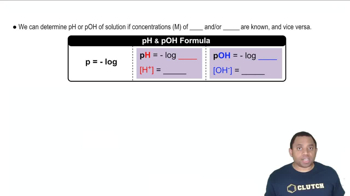Here are the essential concepts you must grasp in order to answer the question correctly.
Weak Bases and Kb
A weak base is a substance that partially ionizes in solution, establishing an equilibrium between the un-ionized base and its ions. The base dissociation constant (Kb) quantifies the strength of a weak base, indicating the extent to which it can accept protons from water. A higher Kb value signifies a stronger base, while a lower value indicates a weaker base.
Recommended video:
pH and pOH Relationship
pH is a measure of the hydrogen ion concentration in a solution, while pOH measures the hydroxide ion concentration. The relationship between pH and pOH is given by the equation pH + pOH = 14 at 25 °C. In this case, knowing the pH allows us to calculate the pOH, which is essential for determining the concentration of hydroxide ions in the solution, a key factor in calculating Kb.
Recommended video:
Osmotic Pressure
Osmotic pressure is the pressure required to prevent the flow of solvent into a solution through a semipermeable membrane. It is directly related to the concentration of solute particles in the solution, as described by the van 't Hoff equation. In this context, osmotic pressure can be used to determine the molarity of the cocaine solution, which is necessary for calculating Kb.
Recommended video:




